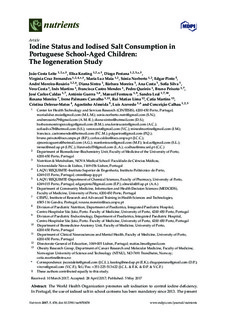| dc.contributor.author | Leite, Joao Costa | |
| dc.contributor.author | Keating, Elisa | |
| dc.contributor.author | Pestana, Diogo | |
| dc.contributor.author | Fernandes, Virginia Cruz | |
| dc.contributor.author | Maia, Maria Luz | |
| dc.contributor.author | Norberto, Sonia | |
| dc.contributor.author | Pinto, Edgar | |
| dc.contributor.author | Moreira-Rosario, Andre | |
| dc.contributor.author | Sintra, Diana | |
| dc.contributor.author | Moreira, Barbara | |
| dc.contributor.author | Costa, Ana | |
| dc.contributor.author | Silva, Sofia | |
| dc.contributor.author | Costa, Vera | |
| dc.contributor.author | Martins, Ines | |
| dc.contributor.author | Mendes, Francisca Castro | |
| dc.contributor.author | Queiros, Pedro | |
| dc.contributor.author | Peixoto, Bruno | |
| dc.contributor.author | Caldas, Jose Carlos | |
| dc.contributor.author | Guerra, Antonio | |
| dc.contributor.author | Fontoura, Manuel | |
| dc.contributor.author | Leal, Sandra | |
| dc.contributor.author | Moreira, Roxana | |
| dc.contributor.author | Carvalho, Irene Palmares | |
| dc.contributor.author | Lima, Rui Matias | |
| dc.contributor.author | Martins, Catia | |
| dc.contributor.author | Delerue-Matos, Cristina | |
| dc.contributor.author | Almeida, Agostinho | |
| dc.contributor.author | Azevedo, Luís | |
| dc.contributor.author | Calhau, Conceição | |
| dc.date.accessioned | 2018-02-01T10:39:03Z | |
| dc.date.available | 2018-02-01T10:39:03Z | |
| dc.date.created | 2017-12-12T20:35:51Z | |
| dc.date.issued | 2017 | |
| dc.identifier.citation | Nutrients. 2017, 9 (5). | nb_NO |
| dc.identifier.issn | 2072-6643 | |
| dc.identifier.uri | http://hdl.handle.net/11250/2481171 | |
| dc.description.abstract | The World Health Organization promotes salt iodisation to control iodine deficiency. In Portugal, the use of iodised salt in school canteens has been mandatory since 2013. The present study aimed to evaluate iodine status in school-aged children (6–12 years) and to monitor the use of iodised salt in school canteens. A total of 2018 participants were randomly selected to participate in a cross-sectional survey in northern Portugal. Children’s urine and salt samples from households and school canteens were collected. A lifestyle questionnaire was completed by parents to assess children’s eating frequency of iodine food sources. Urinary iodine concentration (UIC) was measured by inductively coupled plasma-mass spectrometry. The median UIC was 129 µg/L which indicates the adequacy of iodine status and 32% of the children had UIC < 100 µg/L. No school canteen implemented the iodised salt policy and only 2% of the households were using iodised salt. Lower consumption of milk, but not fish, was associated with a higher risk of iodine deficiency. Estimation of sodium intake from spot urine samples could be an opportunity for adequate monitoring of population means. Implementation of iodine deficiency control policies should include a monitoring program aligned with the commitment of reducing the population salt intake. | nb_NO |
| dc.language.iso | eng | nb_NO |
| dc.publisher | MDPI | nb_NO |
| dc.rights | Navngivelse 4.0 Internasjonal | * |
| dc.rights.uri | http://creativecommons.org/licenses/by/4.0/deed.no | * |
| dc.title | Iodine status and iodised salt consumption in portuguese school-aged children: The iogeneration study | nb_NO |
| dc.type | Journal article | nb_NO |
| dc.type | Peer reviewed | nb_NO |
| dc.description.version | publishedVersion | nb_NO |
| dc.source.volume | 9 | nb_NO |
| dc.source.journal | Nutrients | nb_NO |
| dc.source.issue | 5 | nb_NO |
| dc.identifier.doi | 10.3390/nu9050458 | |
| dc.identifier.cristin | 1526484 | |
| dc.description.localcode | © 2017 by the authors. Licensee MDPI, Basel, Switzerland. This article is an open access article distributed under the terms and conditions of the Creative Commons Attribution (CC BY) license (http://creativecommons.org/licenses/by/4.0/). | nb_NO |
| cristin.unitcode | 194,65,15,0 | |
| cristin.unitname | Institutt for klinisk og molekylær medisin | |
| cristin.ispublished | true | |
| cristin.fulltext | original | |
| cristin.qualitycode | 1 | |

